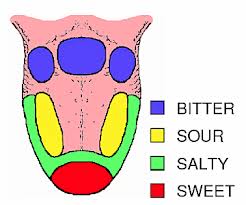Issue 9, Taste and “the nose pinch test”?
I thought a December newsletter was the perfect time to write about our sense of taste! The tastes of the season take over…turkey, gravy, perogies, spanakopita (yes, a perfect combination of Ukrainian and Greek food in my house!) and of course the desserts, including chocolates! Our sense of taste is interesting and not what you might think.
Brainwaves is a monthly newsletter designed to create some “brainwaves” within my community of colleagues, friends and clients.
The last issue was about folks who need to chew, especially when they are thinking, writing or reading. This issue is also about chewing, but about what we taste and how we taste it … keep reading, you might be surprised!
Taste includes four areas; bitter, sour, salty and sweet. Although we all believe that our tongue is our main organ of taste, it is really only capable of tasting these four categories. Those of us that are “supertasters” have more taste buds in a particular area of the tongue. Researchers state that this is usually due to genetics.
There is research to suggest that certain situations alter our perception of taste including pregnancy, chemotherapy, aging, seizures, drug use, and changing our diet. Some doctors suggest (experience and anecdotal evidence) that eating unhealthy foods, particularly those foods high in sodium and unhealthy fats that contribute to obesity, causes reduced sensitivity to taste.
In an article on The Huffington Post, David Katz, M.D., Director of the Yale Prevention Research Center, suggests that when we inundate our taste buds all day long with sugar, salt, and chemicals, they become insensitive to them. If you regularly eat high sugar and high sodium foods, this news can be discouraging. However, better food choices, even cutting down on sugar and sodium intake for just a few weeks can change your preferences and your sensitivities to salt and fat. (http://psychcentral.com/blog/archives/2012/09/28/does-obesity-change-your-sense-of-taste/)
What is flavour? Gordon M. Shepherd, professor of neurobiology at the Yale School of Medicine, has spent a lifetime researching the brain mechanisms involved in olfaction (our sense of smell) and its impact on flavor perception in the brain. His book is “Neurogastronomy: How the Brain Creates Flavor and Why It Matters,” provides a detailed look at just how smelling in the nose, mouth and brain produces the unique experience of flavor that we associate with eating our favorite or least-favorite foods. As he researched flavor, he realized that the sense of smell is the dominant sense in flavor and we are almost totally unaware of it. Orthonasal is sniffing in and it happens when we are smelling the aromas in food we are about to eat. Retronasal is called retro because it comes from the back of the mouth, and it’s the way we smell when we have food in our mouths. While we might not be aware of it, vapors that come from our food while we are breathing out stimulate cells in our nose. That is how smell contributes to flavor. We don’t realize it because all we usually notice is the feel of the textures of the food in our mouth.
The nose pinch test? He describes this as one of the simplest ways of giving more credit to smell in flavor. You pinch your nose and put a piece of candy or food on your tongue and ask what the flavor is. With their nose pinched, most people will be able to tell that it tastes sweet and that is all. Once you un-pinch your nose, the whole flavor of the food is able to travel to the brain, and that is all due to smell. As you breathe out, air goes from the back of the mouth up to the nose. Now I understand why I used to pinch my nose when I had to eat cooked carrots as kid! I hated cooked carrots!! (http://www.salon.com/2011/11/26/the_science_of_taste/)
Picky Eaters?
As many of us know some kids aren’t just picky eaters but will refuse almost all foods except for a very narrow few. For kids, eating often means putting something in their mouth for the first t ime. That first sensation of something in their mouth can be quite aversive. Those children likely feel that certain foods elicit a sensory quality that is unpleasant. This is where understanding how the brain creates the sensation of food, with multiple senses, means that a therapist could begin to assess which sensory system is affecting how a child feels about a certain food. Sensory systems involved include taste, smell, touch (texture) and sound (the sound of chewing certain foods). Shepherd states that we can gradually expand a child’s range of tolerances to certain foods.
ime. That first sensation of something in their mouth can be quite aversive. Those children likely feel that certain foods elicit a sensory quality that is unpleasant. This is where understanding how the brain creates the sensation of food, with multiple senses, means that a therapist could begin to assess which sensory system is affecting how a child feels about a certain food. Sensory systems involved include taste, smell, touch (texture) and sound (the sound of chewing certain foods). Shepherd states that we can gradually expand a child’s range of tolerances to certain foods.
Workshops
Understanding Behavior from a Sensation Point of View, February 6 and 20, 2013, 6:45 – 9:00, 468 Academy Road, Winnipeg. Call 204-254-3146 or email [email protected]

